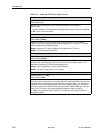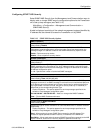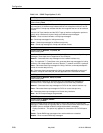
Configuration
3-59
9123-A2-GB20-00
May 2000
Table 3-16. Communication Port Options (2 of 4)
Character Length
Possible Settings: 7, 8
Default Setting: 8
Specifies the number of bits needed to represent one character.
NOTE: Character length defaults to 8 and cannot be changed if Port Use is set to
Net Link.
7 – Sets the character length to seven bits.
8 – Sets the character length to eight bits. Use this setting if using the COM port as the
network communication link.
Parity
Possible Settings: None, Even, Odd
Default Setting: None
Provides a method of checking the accuracy of binary numbers for the COM port. A
parity bit is added to the data to make the “1” bits of each character add up to either an
odd or even number. Each character of transmitted data is approved as error-free if the
“1” bits add up to an odd or even number as specified by this configuration option.
None – Provides no parity.
Even – Makes the sum of all 1 bits and its corresponding parity bit always even.
Odd – Makes the sum of all 1 bits and its corresponding parity bit always odd.
Stop Bits
Possible Settings: 1, 2
Default Setting: 1
Determines the number of stop bits used for the COM port.
1 – Provides one stop bit.
2 – Provides two stop bits.
Ignore Control Leads
Possible Settings: Disable, DTR
Default Setting: Disable
Specifies whether DTR is used.
Disable – Treats control leads as standard operation.
DTR – Ignores DTR. This may be necessary when connecting to some PAD devices.
Login Required
Possible Settings: Enable, Disable
Default Setting: Disable
Determines whether a user ID and password (referred to as the login) is required in
order to log on to the asynchronous terminal connected to the COM port.
Display Conditions
– This option only appears when Port Use is set to Terminal.
Enable – Requires a login to access the menu-driven user interface.
Disable – Does not requires a login.


















